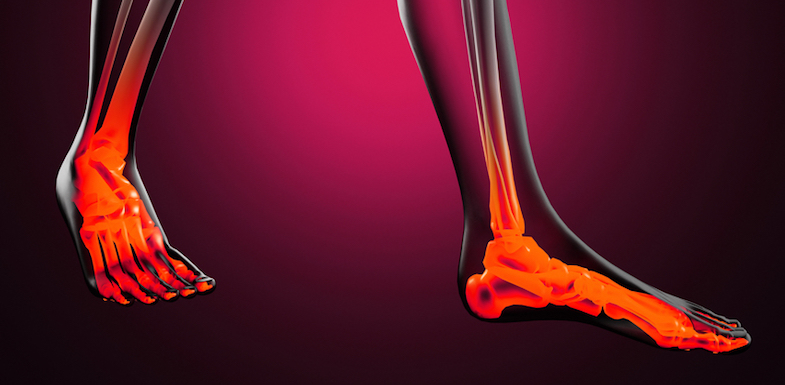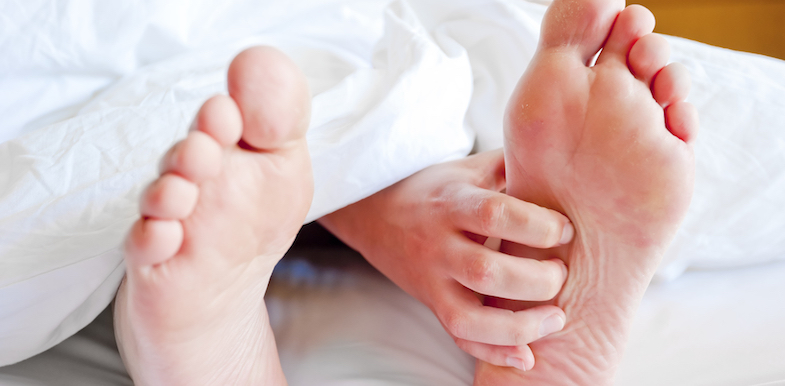
We all know that exercise is a great way to get (and stay) fit and healthy. It’s good for body and soul, but what happens if your exercise causes pain? Heel pain after running is an experience that can sideline runners of all ages and fitness levels. If you have heel pain after running, here’s everything you need to know about it (and how to fix it when it happens).
Why do I have heel pain after running?
We ask a lot of our feet every day, and our heels take a huge brunt of that force. Our feet are incredibly complex and contain 25% of the bones in our body; 100 ligaments, muscles, and tendons; and over 30 joints.
The calcaneus (the heel bone) is the largest bone in the foot. It forms one angle in the essentially triangular shape of the bottom of the foot. The talus bone (our ankle bone) rests on top of the calcaneus. We also have three large bones – cuboid, navicular, and cuneiform – that rest at the base of our toes (what is frequently referred to as the balls of the feet).
Finally, we have the toes, made up of phalanges and metatarsals.
Connecting all of these bones and optimizing our movement and support are muscles, ligaments, and tendons. The heel bone is the origin of the Achilles tendon, a tendon that attaches the calf to the heel itself.
The anatomy of our individual feet determines the placement of the arches of the feet. Together, the heel and arch of the foot distribute the force placed upon the foot as it moves across the ground. This allows us to walk comfortably over uneven surfaces.
There are a variety of reasons why you might develop heel pain after running. The force placed upon a foot when running is three or more times that person’s body weight. This force alone, over time, can strain the structures of the foot and cause pain.

What causes heel pain after running?
A person’s risk of developing heel pain after running can increase or decrease depending on a variety of causes.
Considering the force on our feet, we can break down the reasons why we have heel pain after running into three main categories:
- Plantar fasciitis
- Structural issues
- Poor movement (leading to injury or strain)
Plantar fasciitis
Plantar fasciitis is the most common cause of heel pain from running.
The plantar fascia is a thick, ropy tendon that connects the ball of the foot to the heel. It offers support in the arch of the foot and helps to absorb much of the impact as we walk, run, and go about our daily business.
With overuse, misuse, or injury, this tendon can become inflamed due to overstretching or tearing. In addition to pain that ranges from mild to excruciating, you might also experience one or more of the following symptoms:
- Stiffness at the heel
- Sharp pain in the morning when first putting weight on the foot
- Visible swelling and redness
- Aching arches of the feet
If you experience heel pain after hiking (or running), it’s likely that plantar fasciitis is the cause. Just over 10% of all adults in the U.S. will experience this condition at some point in their lives.
Left untreated, your feet form protective bone spurs on the heel. This is the foot attempting to offer more bony support of the body, but what actually happens is it increases the pain and may require surgery to resolve.
An estimated 70% of people who experience plantar fasciitis also develop bone spurs as a result.
Structural issues
Structural issues in the foot, especially combined with overuse, misuse, or unsupportive footwear, can lead to heel pain after running.
One of the main structural concerns in the foot is the arch. The arches of the foot are like shock absorbers. If they are too high, the shock is concentrated at the apex of the arch. Too low, and there isn’t much shock absorption happening at all. Both of these can lead to excessive strain on the plantar fascia. Further, bone spurs are more likely to develop when the arches are either too high or too low.
Other structural issues that can lead to heel pain when running include:
- Muscle weakness in the calves and other supporting muscles
- Poor alignment (e.g., if the ankles roll inward or outward)
- Injuries or structural issues in the knee or hip that cause a change in the way you use your feet
This last structural issue is more common than you might think. Our bodies are designed to accommodate injury wherever it occurs. Sometimes this means a shift in how we use our feet, even far away from the injury.
Poor movement (leading to injury or strain)
Poor movement, or exercising on unforgiving terrain that causes you to shift your gait, can also lead to heel pain after running.
Runners with weak bones in the feet may experience undetected small fractures that shift their movement slightly. This slight movement adds up when running and hiking (or even walking) long distances.
Falling into the category of poor movement is also excessive movement. Even the most dedicated athletes require cycles of activity and rest. If you are not allowing your body periods of rest and recovery, especially after intense activity, your feet will surely let you know.
Finally, where we run or hike matters when it comes to keeping our feet healthy and strong. Running over rocky, uneven terrain or only sticking to hard, unforgiving pavement can lead to heel pain when running.
Other causes
There are other causes of heel pain after running that are less common but can occur. These include:
- Sever’s disease
- Achilles tendonitis
- Arthritis
Running or other vigorous exercise may not cause these conditions, but their presence can contribute to pain afterwards.
How to prevent heel pain after running
For mild heel pain after running (or heel pain after hiking), the best treatment is really an ounce of prevention.
The first step starts with the basics. Selecting and fitting the best shoes for plantar fasciitis prevention is crucial. If you are an avid runner or hiker, take the time (and spend the money) to go to a shoe store that specializes in properly fitting shoes for exercise. They will analyze your gait and offer several options so you can find the most supportive and comfortable shoes possible.
Other ways to treat mild heel pain after running include the following:
- Rest: Few athletes like to take time off, but tendon injuries require rest. If you experience mild foot soreness after exercise, take a day or two off.
- Ice: Ice is a good idea after running or hiking. Whether you have side heel pain after running or back of heel pain after running, concentrate the ice in that area. Follow a 20 minutes on – 20 minutes off schedule for a couple of hours after exercise.
- Stretch: Even without heel pain after running or hiking, stretching the feet keeps them healthy. You can select a full-body yoga practice that focuses on the feet, or just complete a few foot stretches every day for happy, healthy feet.
The above suggestions are for mild, normal aches that runners or hikers might experience. For long-term healthy, happy feet, these can be applied even when feet aren’t hurting.
If you experience more extreme heal pain, or pain that does not subside after the above treatment and prevention options, it’s time to see your doctor.

Common heel pain treatments
Even the most diligent runners and hikers may experience heel pain that doesn’t go away without further treatment. Here are nine steps you can take (pun intended!) to fix heel pain after running.
1. Medications
Non-steroidal anti-inflammatory drugs (NSAIDs) like ibuprofen and naproxen sodium can help relieve the pain and inflammation of heel pain after running.
2. Rolling massage
Place a tennis ball (or other ball designed for this purpose, like a lacrosse ball) under the arch of your foot and roll all around, placing weight as you can. It can sometimes help to place all of your weight on the ball for a few breaths, releasing after a bit.
You can also freeze a bottle of water and roll that under the arch of your foot to combine the benefits of ice and rolling massage.
3. Tape the foot
Use athletic tape to provide your arches with more support.
Taping can not only provide support for the arches but can also protect against shin splints (another common and painful condition among runners).
4. Use orthotic inserts
If spending money on proper shoes is not in your budget, protect your feet from further damage by finding (and consistently using) orthotic inserts.
Your doctor can recommend custom orthotics, but a temporary fix can be found in the pharmacy as well.
5. Night splints
If the cause of your heel pain after running is plantar fasciitis, a night splint can help. This keeps your foot in a flexed position overnight, preventing the plantar fascia from shortening (and causing pain with that first step in the morning).
6. Maintain a healthy weight
It seems counterintuitive to prescribe weight loss or healthy weight maintenance when pain in the feet prevents you from moving, but the less weight we carry in our bodies means less force on our feet.
If heel or foot pain is keeping you from weight-bearing exercise, consider swimming, cycling, or yoga as you recover.
7. Physical therapy
A skilled physical therapist will design and guide you through a personalized sequence of stretches and strengthening moves to prevent help pain after running.
8. Injections
For pain and inflammation, injections into the bottom of the foot can help.
Some studies have shown that Botox injections for plantar fasciitis may be even more effective than corticosteroid injections, but talk to your doctor about all available options.
9. Surgery
Always a last resort, foot surgery may nevertheless be required to relieve chronic, intractable heel pain. There are a variety of surgeries available. The one that works best for you depends entirely upon the cause of your heel pain after running.
At Arizona Pain, we want to help you enjoy all of the beauty the Arizona outdoors has to offer. We want to keep your feet happy and healthy for whatever activity you choose.
If you are experiencing heel pain after running (or any type of foot pain) and want to find a comprehensive treatment plan, get in touch today!